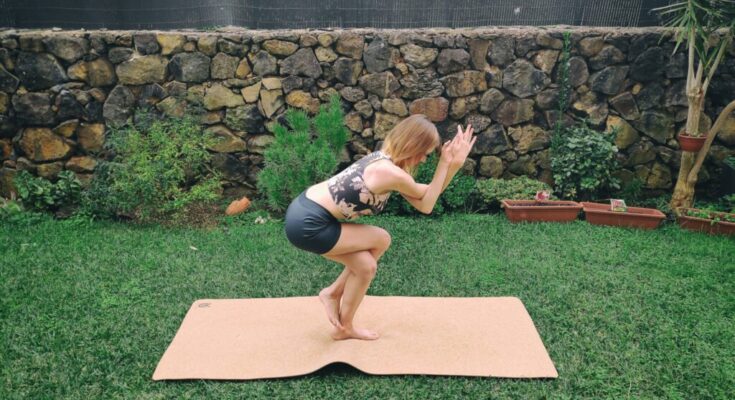✅ Fact Checked
🧘 If you only got 30 seconds:
If you’ve been asking yourself “Why does my yoga mat smell like chemicals?”, you should know that it’s not going to last forever. The characteristic bad odor of a new yoga mat tends to dissipate within a few weeks of usage.
The yoga mat material is usually one of the main causes of the bad smell out of the package. However, the dyes used during the production as well as the overall quality of the materials also play a part.
A chemical smell doesn’t always mean that your yoga mat is off-gassing toxic substances. However, if the smell is really bothering you, you can speed up the odor dissipation by airing out your new yoga mat or giving it a vinegar soak bath.
1/2 Why does my new yoga mat smell?
All new yoga mats smell out of the package. It might be either a very faint smell or a massive off-gassing party.
How bad and how long your new yoga mat will smell will depend on three main factors:
- material it’s made of
- what dyes and glues were used for design (if any)
- how expensive or cheap it is

Material
Yoga mats made of synthetic materials such as PVC (vinyl), PVR, TPE, and NBR will have a distinct plastic and chemical smell out of the package. The reason is not only because there’s a whole lot of chemical reactions and processes going on to create a synthetic product but also because these types of yoga mats are often treated with plasticizers.
Plasticizers add flexibility to your yoga mat and increase its lifespan. They contribute to this chemical smell similar to the one you’ll smell in a new car.
Even so, yoga mats made of eco-friendly natural material can also give away a smell that sometimes lingers for months. Natural rubber yoga mats, for example, are notorious for the bad smell that is nearly impossible to get rid of until it slowly fades away on its own.
The interesting thing is that the main constituent of the natural rubber polyisoprene is odorless. But the smell comes from other “non-rubber” constituents and the production process.
Natural jute or cork mats, on the other hand, smell way less out of the box, but can still initially give off an earthy odor with a hint of dry grass or burlap.
Dyes
The dyes your yoga mat manufacturer is using can also contribute to an unpleasant chemical smell of your new yoga mat.
Some azo dyes have a very strong smell and can release chemicals that have an unpleasant odor. On top of that, dyes can be mixed with acids, metals, solvents, and other toxic substances to make the colors vibrant and durable. Water-based inks, on the other hand, are more eco-friendly and leave less smell on the finished product.
When a yoga mat is composed of two layers, for example, cork and rubber or microfiber and PVC on the bottom, manufacturers can also use glues to secure the two layers together. These glues can also contain toxic chemicals such as formaldehyde that will aggravate the smell on the finished yoga mat.
Price
Expensive doesn’t always mean better. But generally the more expensive the mat and the more reputable the brand, the higher the quality of the materials used.
Manduka PRO yoga mat made of PVC, for instance, will off-gas a bit less and for a short time than some PVC yoga mat from an unknown brand for $10.
High-end yoga brands are more likely to use odorless dyes and avoid toxic glues in their production process, meaning their finished products smell way less out of the package. Reputable yoga brands also have stricter production control and sustainability practices, meaning that people who make your mat are also more protected against harmful off-gassing.

My Favorite Yoga Gear Essentials
I’m picky about my yoga gear
I’m ready to blow some cash on high-quality ethically-made items that are eco-friendly and built to last 🌱 It supports my efforts for sustainable yoga practice and lifestyle.
2/2 Is new yoga mat smell toxic?
Unless you’ve bought the cheapest possible yoga mat, the smell of your new mat does not necessarily indicate that it contains toxic chemicals.
For example, natural rubber yoga mats are free of harmful materials and toxic dyes, but they can be quite stinky at first.
Cheap, low-grade yoga mats made of vinyl (PVC), on the other hand, can contain chemicals like phthalates. Phthalates are linked to reproductive issues including shorter pregnancy duration, and they can leach out over time, especially in warmer temperatures like those found in many hot yoga studios. Phthalate particles then cling to dust, which can be inhaled.
However, not all PVC yoga mats are toxic. High-end brands use better technology and control their production so that no toxic chemicals end up in your mat and in the atmosphere during the manufacturing.

How do you get the chemical smell out of a yoga mat?
Time is your best friend if you want to get rid of the chemical smell from your new yoga mat for good. However, you can try several things to speed up the process:
Air out your yoga mat
Hang your new yoga mat to air out for a few days before using it. If you don’t have an open space to air your mat out, leave it unrolled in a well-ventilated room. You can as well use a fan to promote air circulation. Airing out won’t get rid of the chemical smell entirely, but it will make it fainter and more bearable. Keep in mind that natural rubber mats are heat and sun-sensitive so never expose them to direct sunlight.
Soak your yoga mat
Try soaking your mat for at least one hour in a bathtub filled with hot water (just an inch over your mat) and a cup of vinegar. You can also add a few drops of your favorite essential oil. Once it’s in the tub, rub it down with a soft cloth on both sides. Rinse it and hang it out on a clothing rack to air dry. Alternatively, you can use half a cup of baking soda instead of vinegar.
Use a mat cleaner
You can make a simple DIY cleaner by mixing 50 percent water and 50 percent vinegar into a spray bottle or use a commercial yoga mat cleaner infused with essential oils. The antimicrobial oils I like the most are tea tree, eucalyptus, and lemongrass.
To clean the yoga mat, spray the cleaning solution all over the mat once it has been laid out on a flat surface. Don’t spray too much cleaner onto your mat, as it will soak into it. Using a clean towel, rub the cleaner into the mat in circular motions. Allow your mat to dry unrolled, then flip it over to clean the other side in the same manner. If possible, leave your mat to hang dry over the back of a chair or a porch railing for 12 hours.
Source link




